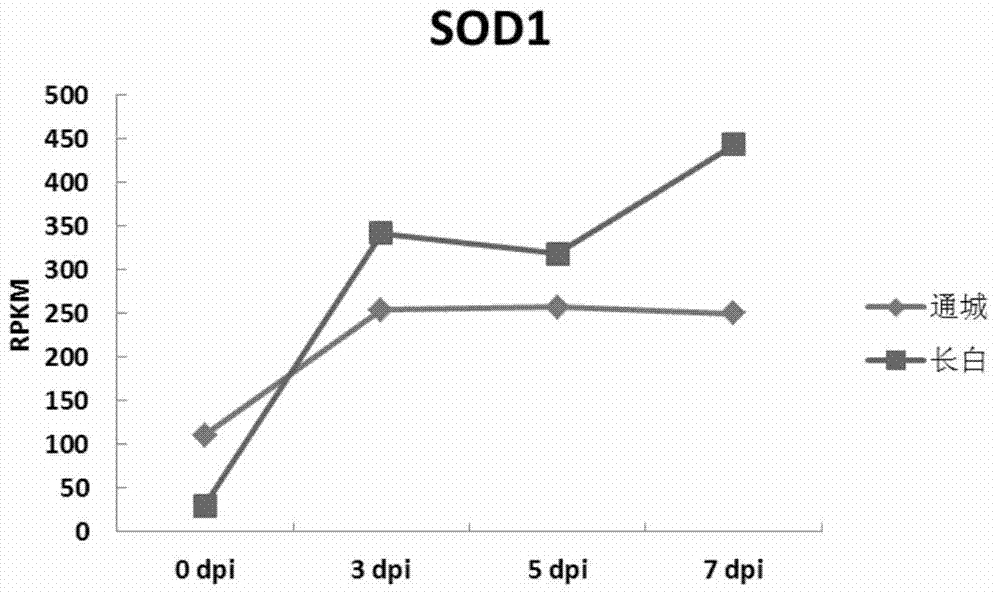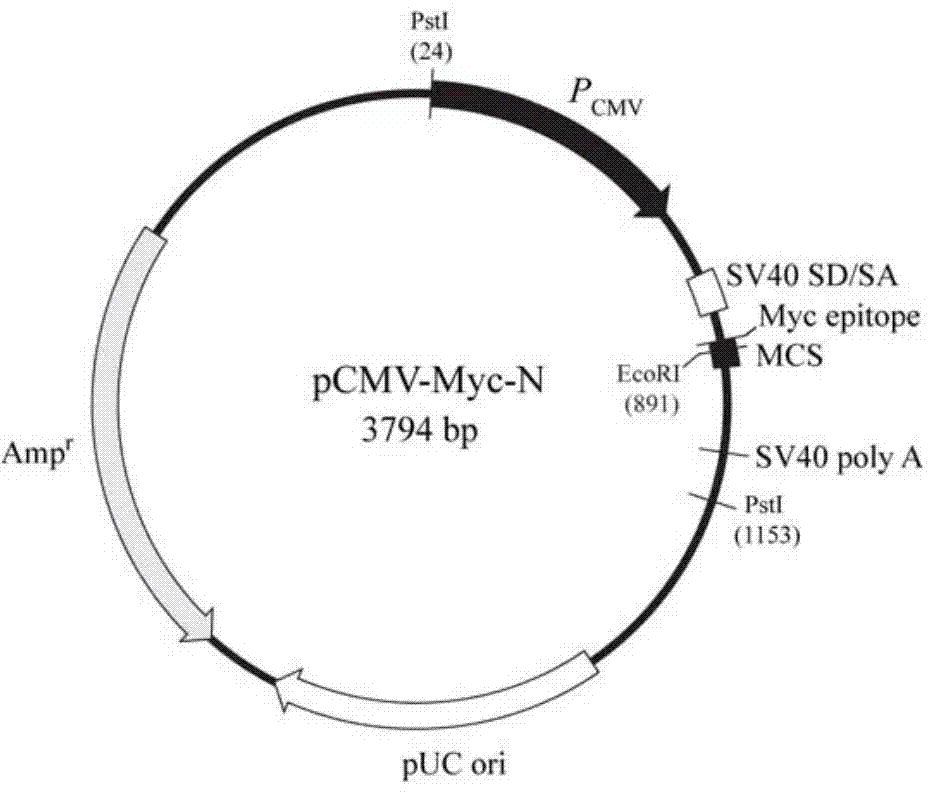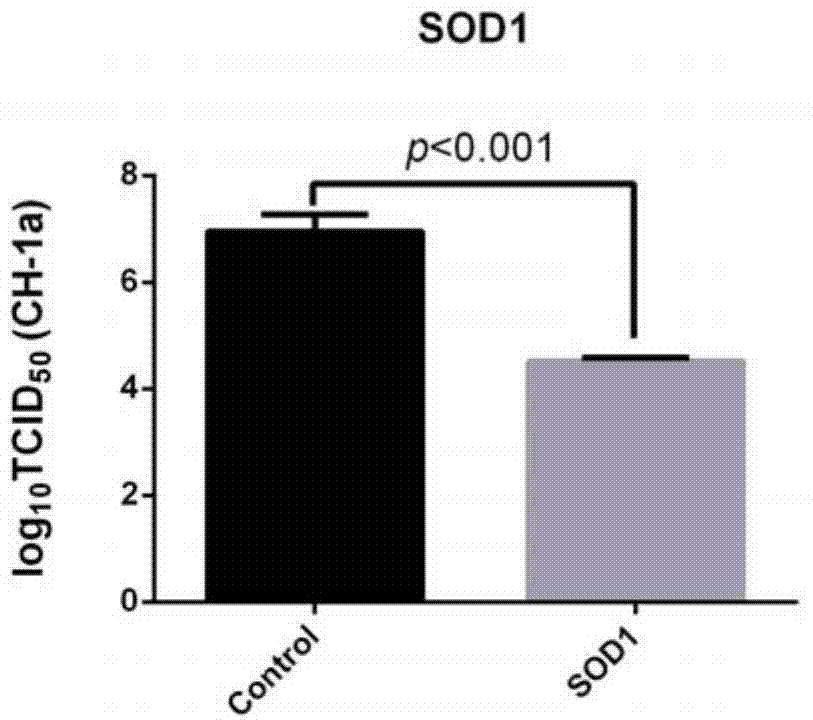Application of porcine SOD1 gene in PRRS (Porcine Reproductive and Respiratory Syndrome) virus resistance
A gene and virus technology, applied in the application field of pig SOD1 gene in anti-PRRS virus, can solve the problems of unable to produce neutralizing antibodies in time, unable to effectively control, persistent infection, etc.
- Summary
- Abstract
- Description
- Claims
- Application Information
AI Technical Summary
Problems solved by technology
Method used
Image
Examples
Embodiment 1
[0023] Example 1 Discovery of a new gene SOD1 resistant to PRRSV infection by analyzing transcriptome data
[0024] Due to differences in the genetic background of different pig breeds and individuals, the resistance to PRRS is also different. Studies have shown that in terms of clinical symptoms and physiological and biochemical indicators, domestic pig breeds such as Tongcheng pigs and Meishan pigs are compared with foreign Landrace pigs, Large white pigs have strong resistance after being infected with highly pathogenic PRRSV. Through the method of high-throughput sequencing, the differential gene expression analysis was performed on the tissues of Landrace pigs and Tongcheng pigs before and after PRRSV infection, and there were significant differences in the expression of some immune-related genes between the two breeds before and after infection. Through the analysis of gene expression differences caused by PRRSV infection among different varieties, not only the infection...
Embodiment 2
[0027] Example 2 Verification of SOD1 Gene Anti-PRRSV Infection Using Cell Biology Research Methods
[0028] 1. Design primers for the SOD1 gene (GenBank accession number is NM_001190422), use reverse transcription PCR technology, reverse transcribe the mRNA and amplify the CDS sequence of the SOD1 gene, the primer sequences are as follows:
[0029] Upstream primer SOD1-F: 5′-GCGTCGAC CATGGCGACGAAGGCCGTGT-3′
[0030] Downstream primer SOD1-R: 5′-CCCTCGAG TTACTGGGTGATCCCAATTAC-3′
[0031] The CDS sequence (SEQ ID No.1) of the amplified SOD1 gene obtained was introduced into the original vector pCMV-Myc-N (purchased from Clonetech Company, and the vector map is as follows: figure 2 shown), construct pCMV-SOD1-Myc vector. Since pCMV-Myc-N has a strong CMV promoter, the SOD1 gene introduced into it can be overexpressed.
[0032] The construction method of pCMV-SOD1-Myc vector is as follows: extract the total RNA of porcine lung tissue, carry out inversion to form cDNA, and use...
Embodiment 3
[0046] Example 3 Preparation method of anti-PRRSV transgenic pigs overexpressing SOD1 gene
[0047] 1. Recovery of donor cells (pig fetal fibroblasts). Take out the cryopreservation tube from the liquid nitrogen, quickly put it into a 37°C water bath, and shake the cryopreservation tube rapidly continuously. After the freezing solution is completely thawed, transfer it to a centrifuge tube, dilute it 3 times with fresh culture medium, centrifuge at 1000rpm for 5 minutes, remove the supernatant, suspend the cell pellet with fresh culture medium, dilute the cells to the required concentration, and inoculate into cultured in a petri dish.
[0048] 2. Using the method of liposome transfection, the target plasmid linked with the SOD1 gene CDS sequence is transferred into the donor cell. The cells were digested by conventional methods, and 0.8 μg of the plasmid pCMV-SOD1-Myc to be transfected and 2 μl of liposome (lipofectamine) were diluted with 100 μl of serum-free medium DMEM. ...
PUM
 Login to View More
Login to View More Abstract
Description
Claims
Application Information
 Login to View More
Login to View More - R&D
- Intellectual Property
- Life Sciences
- Materials
- Tech Scout
- Unparalleled Data Quality
- Higher Quality Content
- 60% Fewer Hallucinations
Browse by: Latest US Patents, China's latest patents, Technical Efficacy Thesaurus, Application Domain, Technology Topic, Popular Technical Reports.
© 2025 PatSnap. All rights reserved.Legal|Privacy policy|Modern Slavery Act Transparency Statement|Sitemap|About US| Contact US: help@patsnap.com



